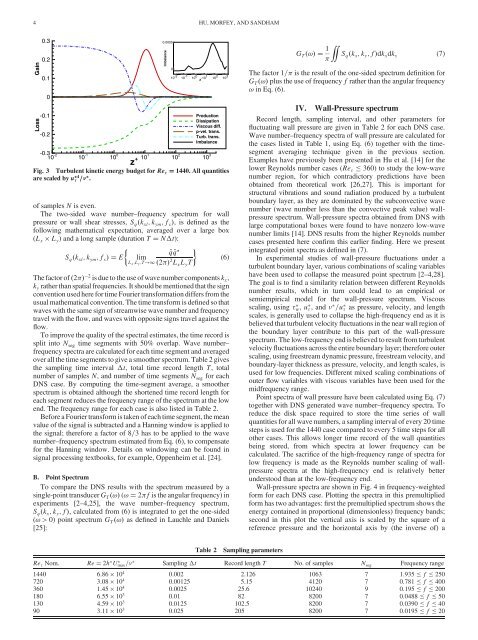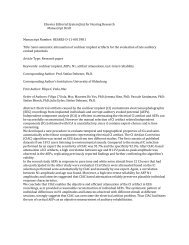Wall Pressure and Shear Stress Spectra from Direct Numerical ...
Wall Pressure and Shear Stress Spectra from Direct Numerical ...
Wall Pressure and Shear Stress Spectra from Direct Numerical ...
Create successful ePaper yourself
Turn your PDF publications into a flip-book with our unique Google optimized e-Paper software.
4 HU, MORFEY, AND SANDHAM<br />
Loss Gain<br />
0.3<br />
0.2<br />
0.1<br />
0<br />
-0.1<br />
-0.2<br />
z +<br />
10 -2<br />
10 -1<br />
10 0<br />
10 1<br />
10 2<br />
10 3<br />
-0.3<br />
Fig. 3 Turbulent kinetic energy budget for Re 1440. All quantities<br />
are scaled by u 4 = .<br />
of samples N is even.<br />
The two-sided wave number–frequency spectrum for wall<br />
pressure or wall shear stresses, S q k xl;k ym;f s ,isdefined as the<br />
following mathematical expectation, averaged over a large box<br />
(L x L y) <strong>and</strong> a long sample (duration T N t):<br />
S q k xl;k ym;f s E lim<br />
L x;L y;T!1<br />
0.0005<br />
^q ^q ?<br />
2 2 L xL yT<br />
The factor of 2 2 is due to the use of wave number components kx,<br />
k y rather than spatial frequencies. It should be mentioned that the sign<br />
convention used here for time Fourier transformation differs <strong>from</strong> the<br />
usual mathematical convention. The time transform is defined so that<br />
waves with the same sign of streamwise wave number <strong>and</strong> frequency<br />
travel with the flow, <strong>and</strong> waves with opposite signs travel against the<br />
flow.<br />
To improve the quality of the spectral estimates, the time record is<br />
split into N seg time segments with 50% overlap. Wave number–<br />
frequency spectra are calculated for each time segment <strong>and</strong> averaged<br />
over all the time segments to give a smoother spectrum. Table 2 gives<br />
the sampling time interval t, total time record length T, total<br />
number of samples N, <strong>and</strong> number of time segments N seg for each<br />
DNS case. By computing the time-segment average, a smoother<br />
spectrum is obtained although the shortened time record length for<br />
each segment reduces the frequency range of the spectrum at the low<br />
end. The frequency range for each case is also listed in Table 2.<br />
Before a Fourier transform is taken of each time segment, the mean<br />
value of the signal is subtracted <strong>and</strong> a Hanning window is applied to<br />
the signal; therefore a factor of 8=3 has to be applied to the wave<br />
number–frequency spectrum estimated <strong>from</strong> Eq. (6), to compensate<br />
for the Hanning window. Details on windowing can be found in<br />
signal processing textbooks, for example, Oppenheim et al. [24].<br />
B. Point Spectrum<br />
To compare the DNS results with the spectrum measured by a<br />
single-point transducer G T ! (! 2 f is the angular frequency) in<br />
experiments [2–4,25], the wave number–frequency spectrum,<br />
S q k x;k y;f , calculated <strong>from</strong> (6) is integrated to get the one-sided<br />
(!>0) point spectrum G T ! as defined in Lauchle <strong>and</strong> Daniels<br />
[25]:<br />
Imbalance<br />
0<br />
z +<br />
10 -2 10 -1<br />
10 0<br />
10 1<br />
10 2<br />
10 3<br />
Production<br />
Dissipation<br />
Viscous diff.<br />
p-vel. trans.<br />
Turb. trans.<br />
Imbalance<br />
(6)<br />
Table 2 Sampling parameters<br />
G T !<br />
1 ZZ<br />
S q k x;k y;f dk xdk y<br />
The factor 1= is the result of the one-sided spectrum definition for<br />
G T ! plus the use of frequency f rather than the angular frequency<br />
! in Eq. (6).<br />
IV. <strong>Wall</strong>-<strong>Pressure</strong> spectrum<br />
Record length, sampling interval, <strong>and</strong> other parameters for<br />
fluctuating wall pressure are given in Table 2 for each DNS case.<br />
Wave number–frequency spectra of wall pressure are calculated for<br />
the cases listed in Table 1, using Eq. (6) together with the timesegment<br />
averaging technique given in the previous section.<br />
Examples have previously been presented in Hu et al. [14] for the<br />
lower Reynolds number cases (Re 360) to study the low-wave<br />
number region, for which contradictory predictions have been<br />
obtained <strong>from</strong> theoretical work [26,27]. This is important for<br />
structural vibrations <strong>and</strong> sound radiation produced by a turbulent<br />
boundary layer, as they are dominated by the subconvective wave<br />
number (wave number less than the convective peak value) wallpressure<br />
spectrum. <strong>Wall</strong>-pressure spectra obtained <strong>from</strong> DNS with<br />
large computational boxes were found to have nonzero low-wave<br />
number limits [14]. DNS results <strong>from</strong> the higher Reynolds number<br />
cases presented here confirm this earlier finding. Here we present<br />
integrated point spectra as defined in (7).<br />
In experimental studies of wall-pressure fluctuations under a<br />
turbulent boundary layer, various combinations of scaling variables<br />
have been used to collapse the measured point spectrum [2–4,28].<br />
The goal is to find a similarity relation between different Reynolds<br />
number results, which in turn could lead to an empirical or<br />
semiempirical model for the wall-pressure spectrum. Viscous<br />
scaling, using w, u , <strong>and</strong> =u as pressure, velocity, <strong>and</strong> length<br />
scales, is generally used to collapse the high-frequency end as it is<br />
believed that turbulent velocity fluctuations in the near wall region of<br />
the boundary layer contribute to this part of the wall-pressure<br />
spectrum. The low-frequency end is believed to result <strong>from</strong> turbulent<br />
velocity fluctuations across the entire boundary layer; therefore outer<br />
scaling, using freestream dynamic pressure, freestream velocity, <strong>and</strong><br />
boundary-layer thickness as pressure, velocity, <strong>and</strong> length scales, is<br />
used for low frequencies. Different mixed scaling combinations of<br />
outer flow variables with viscous variables have been used for the<br />
midfrequency range.<br />
Point spectra of wall pressure have been calculated using Eq. (7)<br />
together with DNS generated wave number–frequency spectra. To<br />
reduce the disk space required to store the time series of wall<br />
quantities for all wave numbers, a sampling interval of every 20 time<br />
steps is used for the 1440 case compared to every 5 time steps for all<br />
other cases. This allows longer time record of the wall quantities<br />
being stored, <strong>from</strong> which spectra at lower frequency can be<br />
calculated. The sacrifice of the high-frequency range of spectra for<br />
low frequency is made as the Reynolds number scaling of wallpressure<br />
spectra at the high-frequency end is relatively better<br />
understood than at the low-frequency end.<br />
<strong>Wall</strong>-pressure spectra are shown in Fig. 4 in frequency-weighted<br />
form for each DNS case. Plotting the spectra in this premultiplied<br />
form has two advantages: first the premultiplied spectrum shows the<br />
energy contained in proportional (dimensionless) frequency b<strong>and</strong>s;<br />
second in this plot the vertical axis is scaled by the square of a<br />
reference pressure <strong>and</strong> the horizontal axis by (the inverse of) a<br />
Re Nom. Re 2h Umax= Sampling t Record length T No. of samples Nseg Frequency range<br />
1440 6:86 104 0.002 2.126 1063 7 1:935 f 250<br />
720 3:08 104 0.00125 5.15 4120 7 0:781 f 400<br />
360 1:45 104 0.0025 25.6 10240 9 0:195 f 200<br />
180 6:55 103 0.01 82 8200 7 0:0488 f 50<br />
130 4:59 103 0.0125 102.5 8200 7 0:0390 f 40<br />
90 3:11 103 0.025 205 8200 7 0:0195 f 20<br />
(7)
















